The Fox House at the North Anna River

On May 23, 1864–155 years ago today–Robert E. Lee sat on the porch of Rev. Thomas Fox’s home, drinking a glass of buttermilk, when Federals appeared on the north bank of the North Anna River a half a mile to the north and opened an artillery barrage. (Read more about that day in this Dec. 2017 post.)
Earlier this month, I had the privilege of joining the American Battlefield Trust for a series of Facebook LIVE events covering the 1864 Overland Campaign, including some time along the North Anna battlefield. One of the real thrills for me was the opportunity to show viewers around the Fox House, “Ellington,” which sits along modern Route 1.
In November 2017, the Trust undertook an effort to preserve the Fox House and 126 acres of surrounding property, which is just the latest effort on their part to save this forgotten battlefield. Meanwhile, since looking around inside the house, I’ve been trying to find out more about the house’s history.
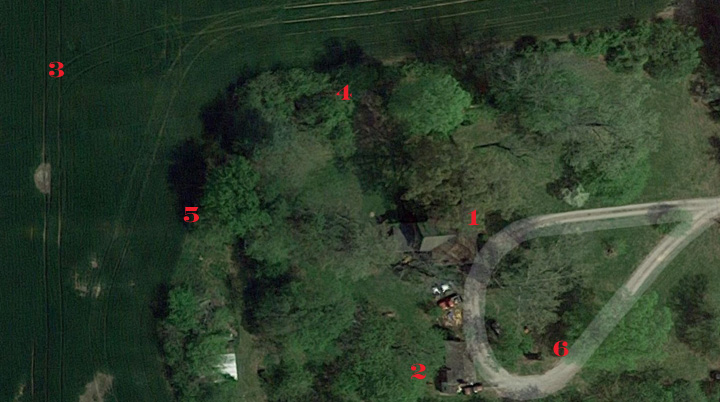
First, let’s take a look at the property from the air. This image comes courtesy of Google Maps. The top of the image is north. I’ve numbered a few of the key features of the property, based on conversations with the Turner family, which owned the property since the early Sixties prior to the Trust’s purchase.
- The Fox House, also known as “Ellington”
- Reverend Thomas H. Fox, who owned the house, also ran a school on the property. A brick building next to the main house had served as the school.
- The slave cabins sat along a ridge in this field.
- The former ice house sat in this area. Today, there’s little more than a depression in the ground. For decades, the house’s occupants used the ice house’s deep pit as the location of their burn pile, ultimately filling most of it in over time.
- A small white building sits behind the main house; nearby is a depression in the ground that marks the former location of the outhouse.
- The Turner kids used to play baseball in the front yard and used a sinkhole in front of a tree as home plate. A few years ago, the sinkhole caved in, revealing the stone walls of an old root cellar.
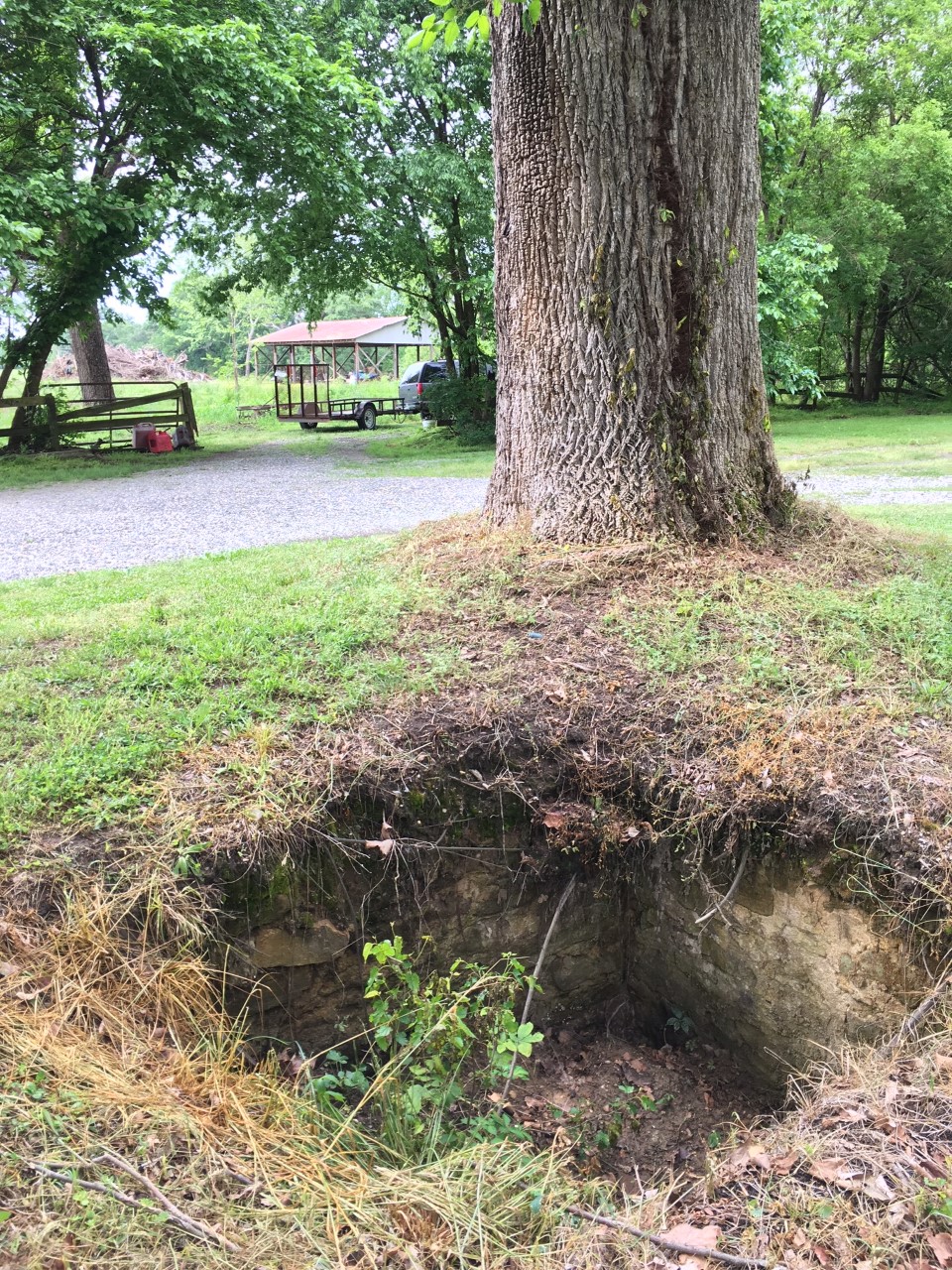
Note that the driveway stretches east, where it connects to Route 1, modern Jefferson-Davis Highway. That in itself is not a surprise except that the old Telegraph Road, build prior to the war, ran about a quarter of a mile to the west of the Fox House. (The property includes the old road trace.) Typically, a house built at the time would face the main road.
However, most of the plantation’s property stretched to the east, so it might make sense for the house to face in that direction. The placement of the outhouse and the slave cabins on the west side of the cabin also suggest that they’d be “behind” the house.
The Fox House is a Georgian-style home, meaning that a main breezeway divides the interior of the house in half, and each side of the house is relatively the same. It could be that, once upon a time, the house did face the Telegraph Road but was later “re-faced” toward Route 1 when the modern road was built. (Chatham Manor in Fredericksburg, a grand old Georgian mansion, was once re-faced in similar fashion.) If the house did once face the Telegraph Road, no trace of that remains on the exterior of the house today; an addition to the west side of the house does obscure much of that exterior wall, though. It bears further study.
One thing we do know is that by the 1930s, the house faced Route 1 and a large portico had been added:
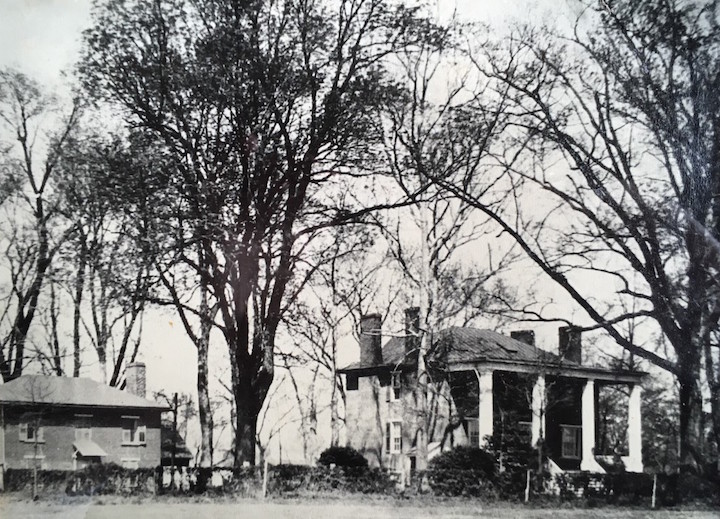
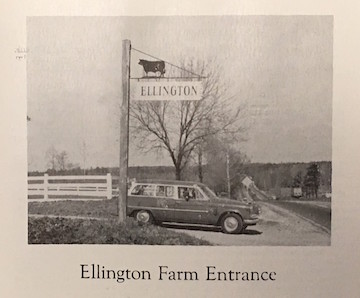 By 1955, the portico was gone. A booklet for a cattle auction held on the site in May of that year described “Beautiful historical Ellington” and featured a picture of the home on its cover. “You will find Ellington cattle to be rugged boned, deep bodied, short legged cattle of the right type, style, and quality. For years Mr. Blanton, owner of Ellington Farms, bought many of the tops from various auctions in Virginia and great sales over the land. He has never used anything but outstanding herd bulls.”
By 1955, the portico was gone. A booklet for a cattle auction held on the site in May of that year described “Beautiful historical Ellington” and featured a picture of the home on its cover. “You will find Ellington cattle to be rugged boned, deep bodied, short legged cattle of the right type, style, and quality. For years Mr. Blanton, owner of Ellington Farms, bought many of the tops from various auctions in Virginia and great sales over the land. He has never used anything but outstanding herd bulls.”

The last photo I’ve been able to find is an arial view that comes from the Turner family, which they date to sometime in the 1990s.
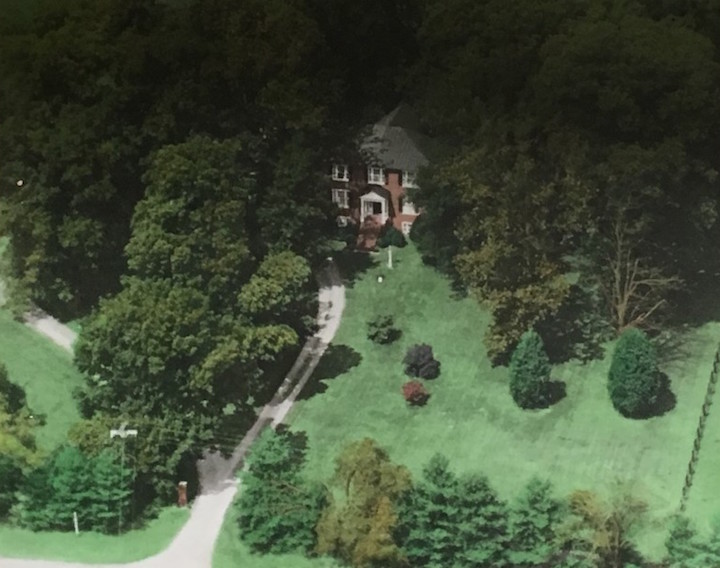
Obviously, there’s much more to learn, including such basic facts as
- When was the house built?
- Did the house ever face west?
- What’s the succession of ownership?
- What more can I find out about Rev. Fox?
- How many slaves once lived on and worked on the plantation?
I’ll be able to find out more by taking a run down to the Hanover County clerk’s office and checking out the tax roles and census records and such (after all, it’s only been a couple weeks since I’ve started poking around about this). I’ll keep you posted!
In the meantime, if you’d like to help support the ongoing preservation efforts at the Fox House, visit the American Battlefield Trust. Here’s a video I did for the Trust, talking about the importance of the property, as part of their campaign.
Chris –
Thank you for this excellent, excellent work and reporting. The Overland Campaign is so important, especially for civil war buffs in our area. I have pulled into the drive of the Fox home many times but did not want to intrude so didn’t get close. This report brings to life an important piece of local history. I did not realize the property had been purchased by the Trust – – just looking at the house from the road one thought it was not going to be standing for long if it remained in private hands. Please continue to report as events warrant.
Thanks, Jack. I’ll keep you updated, for sure. The Fox House was a great catch for the trust.
Nice article on the Fox house, Chris. Great news that it’s now owned by the CWT. Does the CWT’s parcel include the Telegraph Road Bridge ruins?
Yes, it does! Huzzah!
Chris I have a transcription of a letter from Lt. William C. Nelson, a Mississippian who served on the staff of Harris’ Brigade. Thomas Fox is his uncle and in a letter dated May 29, 1864 Nelson writes home to describe a visit with Fox at Ellington and a description of some of the property damage after the Union Army has moved on. If you don’t have it I’ll send a copy via the ECW site.
What plans do the ABT have for this home? It would be great to restore the 19th century porch and roof line.
Was the school house ever a finishing school for girls in the early 1900’s ?
I taught US History at Patrick Henry HS in Ashland. I know Dan ( and his sister) .
At one time, he showed in class a pre-war diary/ journal. Have you seen it?
Thanks, keep digging- Ed Gilkey